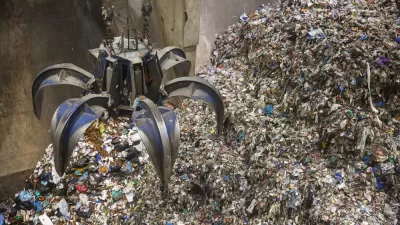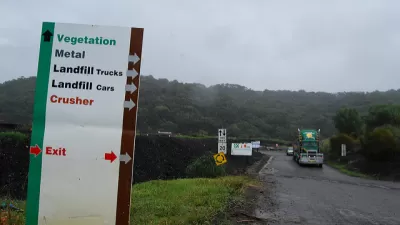Waste-to-Energy

Recyclables Headed to Incinerators or Landfills
China's decision to halt imports of most recyclables from the United States has caused turmoil. With few markets for their recyclables, Philadelphia is sending half of them to a waste-to-energy incinerator in Chester not designed to burn them.

The Value of Garbage Has Changed Dramatically
Recycled metals, plastics, glass, and other materials are more economical than ever. Welcome to a new era of waste management.
First New U.S. Waste-to-Energy Plant in 20 Years to Open in Florida
Waste-to-energy plants, or incinerators, are classified as renewable power plants by the EPA. A controversial Baltimore plant is under construction as well. More common in Europe, they may be catching on stateside due to low recycling rates.
Making NYC's Sanitation and Waste Disposal Sexy
A new six-part video series from The New York Times called "Living City" is aiming to make the infrastructure handling New York City's basic needs sexy.
Pop Quiz: What's the Difference Between Aerobic Decomposition and Anaerobic Digestion?
Yes, one is with and the other without oxygen, and both divert waste from the landfill—but in terms of the end products, what is the advantage of anaerobic digestion? Simply put, does society face a shortage of compost or renewable energy?
Small Cities Explore Sustainable Energy Solutions
From solar panels to waste-to-energy to geothermal systems, small cities across Minnesota are exploring ways to take advantage of the latest in distributed energy generation technologies to reduce costs and improve local economies.
Can America Salvage Its Waste-to-Energy Opportunities?
With 87 total waste-to-energy plants in the U.S., the country is only able to convert 12 percent of its trash to electricity (compared to 38 percent for Germany, for instance). Why is America still sending 55 percent of its trash to landfills?
'Multi-Story Stomach' Solves Supermarkets' Spoiled Food Problem
A first of its kind waste-to-energy plant in Los Angeles produces enough energy to power 2,000 homes per year by processing 150 tons of spoiled supermarket food per day. Could this model help other grocers reduce their environmental footprint?
Solving Sweden's Trash Deficit
You read that right, Sweden's trash problem is that it doesn't have enough of it. Due to a spectacularly successful rate of recycling, the country doesn't have enough garbage to power its waste-to-energy program. It's solution: import trash.
Converting Excess to Energy in NYC?
Jarrett Murphy writes of a single but significant line in Mayor Bloomberg's recent State of the City address which offers a potential solution to the city’s intertwined fiscal, garbage and energy problems.
Urban Design for Planners 1: Software Tools
This six-course series explores essential urban design concepts using open source software and equips planners with the tools they need to participate fully in the urban design process.
Planning for Universal Design
Learn the tools for implementing Universal Design in planning regulations.
Heyer Gruel & Associates PA
JM Goldson LLC
Custer County Colorado
City of Camden Redevelopment Agency
City of Astoria
Transportation Research & Education Center (TREC) at Portland State University
Jefferson Parish Government
Camden Redevelopment Agency
City of Claremont


































